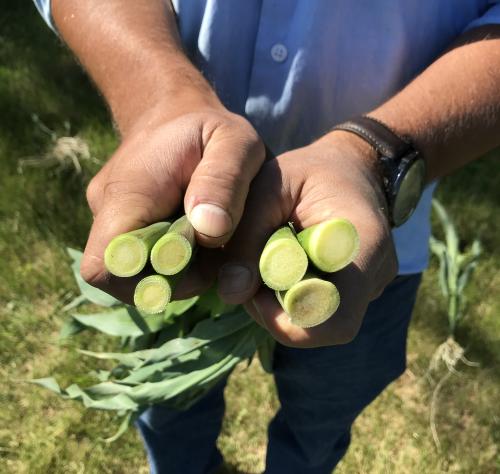A Bad 2019 Might Equate to a Good 2020 for Biofertilizers
One year ago, agricultural watchers had high hopes for many biologicals, especially the biofertilizers segment. According to most analysts, the continual desire to boost crop yields by whatever means possible by growers had the marketplace poised to begin trying these products in larger numbers.
“The key trends in the industry right now include a continued and growing interest in utilizing new product technologies with natural and organic components to promote root growth, soil health, and crop production,” one biofertilizer company representative said in the 2019 CropLife® Biologicals Special Report. “Products that cannot only improve yield but also positively affect harvest grade and/or sizing in specialty crops, along with shelf life and nutritional quality, are gaining interest.”

A comparison of corn stalks grown with EnzUp (right) and without.
But then 2019 happened. With an extremely wet spring, delayed crop plantings, and prevent plant acres dominating the headlines (and, by extension, much of the nation’s farmland), 2019 was a “very difficult year in terms of timely planting and harvest,” according to virtually everyone CropLife talked with regarding the biofertilizers market last year.
“The real driver going into 2019 was efficiency on the farm and maximizing return on investment on all inputs,” Alex Duffy, National Product Manager for Timac Agro USA, says. “The weather of 2019 caused some tough lessons on keeping and maintaining nutrients in the root zones of the plants.”
But in the long run, this “roughness” for agriculture during 2019 might turn out to be a good thing for the prospects for biofertilizers once the 2020 growing season gets into full swing, Duffy adds.
“Going into 2020 is different from 2019 because of the tough spring of 2019,” he says. “With the low commodity prices and the weather causing nutrients to move through the soil, it is opening dealers to the idea of additives that aid in nutrient management and biofertilizers. (Last year) also provided some really good examples in the field of how the products can help to protect the nutrients that farms have invested in and keep them available to plants despite tough environmental conditions. Additives make the most sense because farmers can still use the same cost-effective nutrients, with a simple add-on that protects and still provides an opportunity for a good return on investment in yield.”
Others in the market still see some obstacles ahead for biofertilizers. “As we go into 2020, getting biofertility products added to the at-planting fertility will be a challenge due to the heightened urgency to get planting completed,” Tommy Roach, Vice President of Specialty Products and Technical Services at Nachurs Alpine Solutions, says.
“New product offerings that promote improved-use efficiency are becoming more numerous, but more information about mode of action and yield is needed.”
Key Drivers in 2020
According to Chandra Roberts, Marketing Director for BRANDT, one of the key biofertilizer trends becoming evident this year is the use of combined enzyme and micronutrient products. In this pairing, enzymes act as catalysts to convert organic matter into smaller, more digestible units and boost soil health. Meanwhile, the micronutrient component helps activate enzyme activity.
“The biggest overall benefit of using enzyme technology is increased soil activity, early plant vigor, and increased root mass and stalk diameter,” Roberts says. “Early plant vigor is key to plant health, getting crops off to a good start for the growing season.”
Tying into this trend, BRANDT’s EnzUp biofertilizer for corn, cotton, and soybeans performed very well in 2019, with “sales increasing 500% over the previous year,” she says. “(And) we expect to see strong continued growth in the coming years as growers see efficacy and return on investment.”
At Nachurs, the company is continuing to see its Bio-K products gain traction in the industry. “The fascinating thing about Bio-K products is that not only is it a primary plant nutrient, potassium, but it also improves both nitrogen and phosphorus use efficiency when utilized in-furrow, foliar, sidedress, and/or fertigation applications,” Roach says. “The acetate anion is also the starting foundation for primary and secondary metabolite production inside the plant, which are used to enhance crop maturity and improve yield.”
Of course, many biofertilizer providers have spent a good portion of their time these past few years trying to more broadly tap into the Midwest and Mid-South regions. “With the complex market dynamics in the Midwest/Mid-South, specialty products are a tough sell,” says Timac’s Duffy. “The growers need to be confident in the research and see it work on their ground before they use it.”
But, he adds, Timac is seeing much more interest from distributors in these parts of the country because of the challenges faced in 2019.
“We have introduced our starter fertilizer additive Duo Maxx in the Midwest with some very good success,” Duffy says. “This product is designed to go in-furrow or 2X2 with the starter fertilizer and help stabilize nitrogen, prevent retrograde tie-up of phosphorus, and keep potassium available to the plant.”






